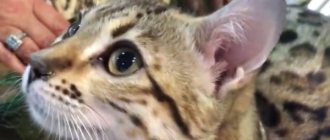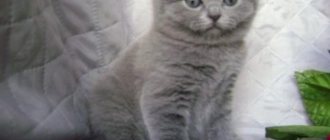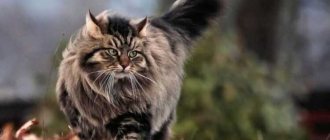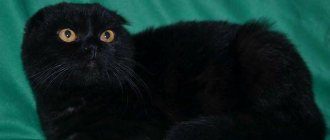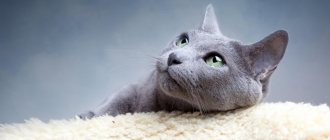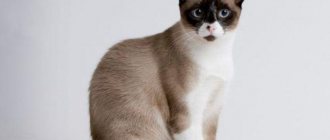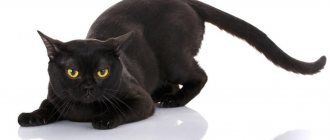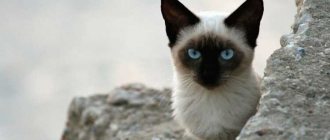Almost all normal families and elderly people keep pets. Animals create a special coziness in the home, bring joy to children, and reciprocate their feelings with their owners.
Undoubtedly, cats are extremely popular. Below we will talk about the Bengal breed of these domesticated predators.
History of the origin of the domestic Bengal breed
global $ads_google;
//data-ad-slot=”2475549904″ $ads_google = empty($ads_google) ? false : true; ?> if ($ads_google == false) {?> $ads_google = true; ?> } ?> The goal of breeding the Bengal cat, the founder of the breed, American Jane Mill, considered obtaining a domestic cat that preserved the color of its wild ancestors - this would help focus attention on the serious problem of extermination of leopard cats.
The history of the origin of the Bengal breed began almost 60 years ago, in 1961, when Jane came to Bangkok. This trip became fateful: there she received a baby Asian leopard cat, which is almost impossible to tame. The purchased baby received the name Malaysia and settled down with the new owner. The grown cat gave birth to offspring from a domestic shorthair cat, but the vicissitudes of fate did not allow her to start breeding a new breed.
A new attempt was made by Jane in 1980. She was provided with 9 hybrids of a leopard cat and domestic cats of different breeds. Then Mill fell into the hands of an Indian cat with a golden-orange color, which gave the Bengals a shiny coat called glitter.
The work was long and difficult due to many factors, and ended in success and recognition by the early 90s.
Where to buy and cost
A Bengal kitten can be purchased at the poultry market, by advertisement, from friends or through trusted Internet resources.
A successful purchase is possible if you carefully examine the animal, study the pedigree and know the basic criteria.
It should be noted that the price of a Bengal cat is quite high. The price gap for a purebred individual ranges from 10 to 25 thousand rubles.
Important! When purchasing a breed, you must ensure its authenticity. This means that the seller is obliged to provide the relevant documents, and the external characteristics of the kitten must correspond to those described above.
Pay attention to the colors of the Bengal cat whose litter will be purchased. Typical colors will guarantee a successful purchase. The baby inherits the mother's pattern very similar.
Description and standards of Bengal cats
It is impossible not to notice the external features of an exotic cat. Even when very small, the baby Bengal looks like a leopard. An adult Bengal cat receives the highest reviews and, just from one verbal description, is a true beauty.
According to the WCF standard, the breed must have a number of characteristics.
The head is a wedge with a massive chin and thickened chin pads. Thanks to this structural feature, the animal’s muzzle resembles a tiger’s mouth. This similarity is even more noticeable during yawning, meowing or growling.
The ears are short and set high on the head. They are wide at the base and their tips are rounded.
The nose is large, curved and moderately wide.
The eyes are almond-shaped and very beautiful. Eye color is clear green or golden.
The head is located on a thick and strong neck, which is in ideal proportions in relation to both the head and the body.
A cat of this breed has a large body and strong muscles.
Bengals run around the house on round, large and powerful paws. As usual, the length of the hind legs exceeds the length of the front ones.
The tail is medium in size, does not fluff, and is dense to the touch. The domestic leopard's tail has spots or rings.
Bengals are short-haired creatures with a soft, silky coat.
When interested in a description of a particular cat breed, people who are allergic to the Fel D1 protein first of all find out whether this charming creature is a hypoallergenic animal. Despite the fact that shedding almost does not affect these cats, they themselves carry the entire allergen on their skin.
global $ads_google; //data-ad-slot=”2475549904″ $ads_google = empty($ads_google) ? false : true; ?> if ($ads_google == false) {?> $ads_google = true; ?> } ?>
The breed presents a wealth of colors. A popular color is spotted-striped. This variety has shades of gray, white or red.
The most common and characteristic color of the Leopardette breed makes the cat look like a leopard.
“Sorrel” in cats finishes forming closer to the year. The coat is golden, the spots are chocolate brown, and the tip of the tail is black.
A sign of the marbled variety is spots of a peculiar, non-leopard shape.
Cats in white and gray colors are called "snow leopards". Kittens are born white, only later acquiring their characteristic color.
The colors of the Bengal breed also be called: rosette on gold, rosette on silver, marble on gold, marble on silver, seal links point, seal mink, seal sepia, charcoal, blue.
Glitter and phasing in Bengal kittens
Fazing in Bengal kittens is the process when babies from one month to four months are covered with gray or dull white fur. The name of the process comes from the English word fuzzy - unclear, uncertain. When the baby is more than a month old, the owner suddenly notices that the appearance of the young Bengal is changing. His fur becomes strewn with protruding whitish hairs, and the cat looks shaded. If phasing is severe, it makes it very difficult to see the pattern and color of the skin. The full beauty of the fur coat returns to eight months of the animal’s life.
Phasing does not manifest itself in every Bengal kitten.
The breed is characterized by glitter - a particularly strong shine to the coat. This is not a mandatory parameter for exhibitions; you can purchase a cat with or without glitter, since the standard allows both types for all representatives of the breed.
Dimensions and weight of Bengals
When buying such a pet for a home, the owner should imagine how big a Bengal cat grows. The height of an adult animal at the withers is 40-41 cm. The animal grows to this established norm by 1.5 years, but the complete completion of growth processes is completed by the age of two years.
The typical weight of purebred cats is 3.5-5.5 kg. An adult male is more massive than a female and weighs 5-8 kg. Animals of both sexes are larger and smaller than the declared weight, but this does not happen often.
If a cat seems very large and its weight is quite high, this does not mean that obesity has appeared: Bengals are nimble and energetic creatures, and, most likely, their body weight is due to the pet’s excellent physical shape and well-developed muscles.
The body length of an adult handsome leopard is about 90 cm, and the height at the withers is 40-41 cm.
global $ads_google;
//data-ad-slot=”2475549904″ $ads_google = empty($ads_google) ? false : true; ?> if ($ads_google == false) {?> $ads_google = true; ?> } ?> Table of weight of Bengal cats by month
| Age | Female | Male |
| newborn | 65-110 gr | 70-125 gr |
| 1 month | 350-500 gr | 390-560 gr |
| 2 months | 640-1100 gr | 750-1300 gr |
| 3 months | 1.2-1.6 kg | 1.3-2.2 kg |
| 4 months | 1.7-2.6 kg | 2.5-3 kg |
| 5 months | 2.5-3.1 kg | 2.8-4 kg |
| 6 months | 2.8-3.9 kg | 3.1-4.3 kg |
| 8 months | 3.2-4.8 kg | 3.7-5.1 kg |
| 10 months | 3.3-5 kg | 4.3-5.6 kg |
| 1 year | 3.4-5.2 kg | 4.8-6.3 kg |
| 2 years | 3.5-5.5kg | 5-8 kg |
About the coat colors of cats and brown marble cats
In the selection work of Bengal cats, breeders have achieved such results that marble is found in all hair colors without exception, be it the original patterned brown or the newest, still rare blue and black. Another thing is that the characteristic patterns of snow or blue cats do not look so impressive, but they are elegant in their own way. The standard, as in all other parameters of the entire breed, is the brown tabby in its marbled variety. Ideal descriptions are:
- the picture is darker than the background;
- complex, tortuous patterns;
— the direction of the lines is oriented horizontally, without visual tendencies towards verticality and striping;
- presence of at least three shades in color;
— a clear shape of deformed spots is ensured by a darker secondary edging;
- There are spots on the stomach.
The disadvantage of the tabby color is the circular patterns that form a figure on the coat, which experts call a “bull’s eye.” The second significant disadvantage is the lack of contrast between the background color and the shades of the stains. This defect is less common in Browns than in Bengals of other colors.
Characteristics of Bengal cats
The appearance of a Bengal kitten in the house expands the horizons of its owners and narrows their horizons to raising one nimble little rascal. The cat's character is bright and memorable: the combination of the natural intelligence of a predator merges with the soft playfulness and sociability of its domestic ancestors.
Reviews about domestic leopards are similar in that these cats are extremely intelligent creatures, so raising and training them is a pleasure. The family favorite remembers commands easily. It doesn't take long to train your Bengal to use the litter box.
The cat’s adaptation to new conditions occurs quickly; very soon the baby will explore all available places and begin to explore forbidden areas. You can compare the character of a Bengal with the character of dogs - he is just as ready to defend his territory, protect his owner, and carry objects from place to place. During the game, the Bengal pet will easily return the abandoned toy, since he himself is interested in spending time with the owner or his child in this way, which is why it is recommended to train the cat.
global $ads_google; //data-ad-slot=”2475549904″ $ads_google = empty($ads_google) ? false : true; ?> if ($ads_google == false) {?> $ads_google = true; ?> } ?>
Cats welcome the company of their beloved household members and are very talkative, but you should not cuddle the animals. Cats are also good with other domestic animals and can make friends with dogs. Bengal girls are well socialized, but they do not approve of communicating with strangers - they need time to understand whether a person entered the house with good intentions.
The animal picks up the mood of its owners very accurately, reacts sensitively to changes in tone of voice, and remembers the words addressed to them.
Raising a cat should start as early as possible. Bengalis are very socialized, they learn understanding and learn about the world from a person's voice. In addition, these cats, like dogs, remember words and are able to follow commands.
They regularly devote time to raising the spotted cat, mainly by playing with the young predator. The game allows the Bengal pussy to show the predatory instincts of a hunter and learn an acceptable behavioral model. Aggressive actions of a cat must be stopped, so it is important to know how to properly raise a cat.
Bengal cats definitely need physical exercise: cats' access to heights is encouraged.
Character and behavior
These seemingly wild cats are completely domestic in nature. However, they have a zest and excitement that makes them look like real little jaguars. Bengal cats become attached to their owner and open up to him. Some pets can be short-tempered and become tense when someone tries to enter their personal space. But Bengal will always treat his beloved owner with confidence and remain loyal.
Warning! Representatives of this breed have a very developed hunting instinct, so they should not be left alone with poultry and rodents. Bengal could become a threat to them.
If a cat has access to the street, it will almost certainly hunt mice, lizards and other animals that are attractive to it, although it is unlikely to eat the prey.
Bengals are natural leaders. They gather all the pets around them, if there are any in the house, always becoming the center of attention and setting the atmosphere. These cats are gentle, love and appreciate affection. However, they may not allow themselves to be touched if they are not in a good mood.
Representatives of the breed need their own personal space, as they have a certain need to sometimes retire. It’s better to immediately buy your pet a special house or at least a carrying bag. You cannot force yourself on these cats, however, given their strong character, you also cannot indulge them. You need to find that golden mean when you can combine patronage, education and respect. Bengals have a subtle mind, so finding a common language with your pet will not be difficult at all.
Does it really look like a leopard?
Bengals treat new people differently. They can be distrustful or, on the contrary, take the initiative and be the first to get acquainted with interest. Representatives of the breed never cease to amaze their owners.
These cats are naturally tolerant and funny, but sometimes they can get into a frenzy, succumbing to the hunting instinct, and behave unintentionally harshly in play.
Bengals are very stubborn and will never do anything they don't want to do. But usually this trait is not a problem, since representatives of the breed are sensitive and understanding, and they learn well.
Care and feeding of Bengals
A short-haired cat brings less worries at home than its long-haired counterparts, which makes caring for your pet much easier. Keeping and caring for a cat is not difficult: 2-3 times a week, devote a little time to combing the fur, which a soft rubber brush will help with. Sometimes you may not even notice the shedding, but once the procedure has begun, it is better to comb the kitty more often.
The descendant of a wild leopard cat needs to trim its claws once every couple of weeks. The ears are cleaned at the same intervals with a damp cotton pad.
It is also necessary to take care of your pet's oral cavity by brushing its teeth once a week.
The bath easily becomes a favorite place for the Bengal, who happily hits the water with his paws. Washing is allowed in rare cases using special cat shampoos.
Feeding a Bengal kitten occurs from month to month according to the feeding schedule and recommendations of specialists. Good nutrition quickly turns a small cat into a healthy, strong cat.
What to feed a Bengal kitten for 2 months
They also feed raw meat (beef or rabbit), exclude raw offal from the diet, replacing them with boiled sea fish once a week. Dairy products in the form of kefir, baby cottage cheese without any additives, and low-fat cream are useful for cats. The daily food intake also involves the addition of vegetables not exceeding a quarter of the volume of meat products. These are carrots, tomatoes, bell peppers. A Bengal cat can be switched to premium and super premium dry food, which the animals eat with benefit and pleasure.
Keeping a neutered cat involves replacing natural nutrition with specialized food.
What to feed
Feeding a one-month-old kitten is difficult. And therefore, it is also not recommended to take the baby away from the mother at this age, but if this happens, then you need to follow a lot of different rules. First of all, about the number of feedings per day. There must be at least six of them. Read more about this in a special article.
Representatives of the breed have sensitive digestion, so it is important to pay special attention to the freshness and quality of the foods your pet eats. You need to decide on the type of feeding for your pet - natural food or ready-made branded food.
In addition, it is better not to change the diet, and if the need arises, transfer to a new type of diet smoothly. When feeding natural products, you need to enrich the diet with vitamins and mineral supplements.
Bengals benefit from natural products:
- cereals (rice, oatmeal, buckwheat);
- seafood (sea fish, boiled and boned);
- meat is required (beef, turkey, rabbit, chicken is acceptable);
- fermented milk products (cottage cheese, low-fat kefir, yogurt, fermented baked milk);
- boiled chicken eggs;
- You can add vegetables in small quantities (pumpkin, carrots).
With such a diet, you need to accurately calculate the proportions of products, choose the right combinations of them, and be sure to introduce vitamin and mineral supplements into the diet to compensate for the lack of essential substances.
You can give preference to ready-made branded food. It is important to use only products that are at least premium, as this is the only product they will willingly eat. Both canned food and dry coma are suitable for Bengals. It is difficult to immediately suggest the best dry food. A suitable company is selected only on an individual basis and does not change the manufacturer unnecessarily.
Remember that there are special automatic cat feeders for both dry food and natural feeding. With its help, many nutrition problems are solved. And if you add an automatic drinking fountain, then all problems with water will be solved.
Mixing different types of feed - products from different companies, natural and ready-made feeds - is not allowed. It is also dangerous for your pet’s health to introduce spices into your pet’s diet, treat him to fried foods, sweets and baked goods.
Bengal cat kittens
Health of the Bengal cat breed
Fortunately, thanks to breeding work and natural hereditary immunity, Bengal exotic beauties have excellent health indicators. But if their immunity resists most feline diseases, then there are some genetic diseases, the fight against which in many cases is quite successful.
global $ads_google; //data-ad-slot=”2475549904″ $ads_google = empty($ads_google) ? false : true; ?> if ($ads_google == false) {?> $ads_google = true; ?> } ?>
The most common phenomenon is “dry nose syndrome.” This problem can occur in kittens up to one year of age. You can't miss a dry nose: cracks and crusts on the surface of the nose become ulcers. In general, this condition is not critical to health and does not cause any special problems for the animal itself. To know for sure whether a dry nose promises trouble, it is better to consult a veterinarian - it happens that this condition develops into an ulcerative lesion of the nose. The doctor prescribes timely treatment that will help restore the healthy state of the nasal surface.
Bengals are sensitive to poor quality food, so to avoid loose stools, the cat is fed only selected food and always provides the pet with fresh water.
There are two serious genetic disorders: hypertrophic cardiomyopathy (HCM) and flat chest syndrome (FCK) in kittens. In the first case, observations and testing are mandatory; proper care will allow the cat to live a long and good life. The second problem is a serious obstacle to the survival of kittens and is looking for a solution. If a Bengal cat was taken from a cattery with a good reputation, where inbreeding and the use of antibiotics by the pregnant female were not allowed, the problem is unlikely to affect her and her offspring.
Miniature leopards are vaccinated according to a schedule starting at 8 weeks. All vaccinations are prescribed by a veterinarian.
The life expectancy of a healthy Bengal cat is 14-16 years if it lives under the supervision of attentive and caring owners.
If the cat was taken as a family pet, then you need to monitor the onset of puberty in order to castrate or sterilize the animal in time. The first heat in a Bengal cat occurs at 6-8 months, when the female’s weight reaches 2.5-3.3 kg. Cats “grow up” by 9 months. If you want to get offspring from your pet, you need the obligatory assistance of a specialist in breeding, otherwise even a successful mating, healthy pregnancy and problem-free childbirth do not guarantee full-fledged offspring.
Mating, pregnancy and childbirth
These cats, as a rule, do not have multiple births; breeding them is quite difficult. Usually a cat gives birth to from 1 to 4 kittens, but there are cases of birth of up to 6 cubs. Pregnancy usually proceeds without complications and lasts 56–64 days, and the cat is also able to lamb on its own.
The female begins to estrus at the age of 6 - 8 months, but she is not yet ready to mate. It is better to leave acquaintance with a cat until he is 1.5 years old. In total, estrus lasts, as a rule, 4 - 6 days and occurs no more than 4 times a year. Mating is carried out 3-5 days after the start of estrus.
The offspring of Bengals are strong kittens that take on the strong traits of their parents. Cats are ready to mate from the age of one year, but the optimal period is considered to be from one and a half to two years to five to eight years. Pregnant pets need special care - they should not be subjected to stress, they must be kept at a comfortable temperature, and be attentive to their diet.
This is interesting! There is a difficulty with males - in the first generations, cats are born infertile, then the percentage of sterile males gradually decreases. By the third generation, the number of infertile cats is minimal, and the fourth generation of Bengals is considered true, in which the young have all the necessary qualities.
In the case of a large number of kittens born, there may be a lack of colostrum for all. In this case, it is recommended to supplement the babies with a milk formula made from a dry cat's milk substitute.
An interesting feature of Bengal kittens is phasing. This is a different color of young animals from the color of adult relatives. Bengal cat kittens do not have clear spots, deep shine and a specific coat tone. This feature refers to camouflage mechanisms, which are well developed in wild cats. Until about six months of age, kittens' fur changes and their color is also determined. By 7–8 months, young Bengals already receive a permanent rich color, like adult cats.
If you do not intend to participate in breeding this breed, sterilization is the best option. This is not a punishment! This is a normal and reasonable way to get rid of unwanted manifestations of the reproductive instinct in your pet. You just have to change the cat’s diet a little and that’s it. But this way you will extend the life of your pet.
Buy a Bengal kitten
Nurseries where you can buy a Bengal kitten are quite common in Russia. You won’t be able to save money on buying a descendant of a wild Asian leopard cat if you want to buy a purebred animal that will strictly meet the standards. In the nursery, the buyer will learn all the information about the future cat, its pedigree, and hear interesting facts about the character of the domestic mini-leopard.
The cost of the Bengal remains high precisely because of the difficulties with breeding. The first generation of Bengals will be infertile if they are males. Females of the first generation are crossed with Bengals and a second generation is obtained, where most of the males are sterile. In the third generation from the f2 female, only some males are sterile. The fourth generation are considered true representatives of the Bengal breed, and have a full range of characteristic skills and traits.
The price for a Bengal cat in Russia is:
- pet class
25,000-50,000 rubles; - breed class
50,000-100,000 rubles; - show class from
100,000 rubles
.
What to name a Bengal kitten
When a Bengali boy or girl arrives in the house, the family may have a number of names ready. But before you give the kitten a nickname, you should know that it must begin with the same letter as the name in the passport.
global $ads_google; //data-ad-slot=”2475549904″ $ads_google = empty($ads_google) ? false : true; ?> if ($ads_google == false) {?> $ads_google = true; ?> } ?>
Also, you should not give a new cat the nickname of your previous pet, this is not only a bad omen, but also a careless attitude towards the memory of a deceased or missing pet.
A long name is difficult to pronounce and difficult for a cat to remember. Hissing sounds are welcome, to which the cat will react most quickly. You can experiment and try calling the cat by different names. There is a chance that the animal will choose its own name.
Handy tables have been created with names that might be suitable.
| Girl | Boy | ||
| Julie Dosya Cleo Dotty Shelma Ivy Eva Aida Stesha Fanta Vikki Iksa Yesya Lika Liya | Almira Brandy Toffee Yuni Tori Lynx Klepa Cher Goldie Ulfi Bara Baksa Goldie Lucky Finka | Joshua Joe Alistair Leo Easy Bingo Ike Luntik Wirt Tory Rain Ride Whiskey Martin Ralph | Vince Rick Jacques Mort Indie Byte Drake Knight Spot Fima Gore Chen Zipper Gizmo Weiss |
Advantages and disadvantages
Bengals are bright individuals. Active and playful pets who love their owner and are infinitely devoted to him. These cats have many advantages:
- they have a sharp mind - these pets learn quickly and are able to perform various tricks;
- have a beautiful appearance - recognizable “wild” color and sparkling shine of fur, harmonious features and confident movements;
- these cats feel confident with strangers, but open up only to their owners;
- very clean;
- very playful, tireless;
- affectionate and gentle;
- easy to keep pets.
Despite the excellent characteristics, the Bengals also have some disadvantages:
- too talkative - impatient people can be annoyed by the many different sounds made by Bengals;
- hot-tempered - if the pet decides to retire, it will not let anyone near it;
- prone to kleptomania - they are attracted to bright and shiny things, so such cats, without a twinge of conscience, borrow things they like from their owners;
- stubborn - representatives of the breed try at all costs to do as they see fit (proper upbringing eliminates such antics on the part of the pet).
Although Bengals respect personal space, these cats need human interaction. They also accept other pets well. It may be difficult for older people to cope with such cats; families with small children should also be careful. The best solution is to buy these cats for active young people.
Any kittens are adorable, but these ones are especially
Conclusions about the breed
The Bengal cat deservedly receives praise and admiration, but not only due to its chic external characteristics:
- The cat's character is ideal for sociable and sensitive people. Both adults and children can play with the furry baby;
- if the owner does not have time to care for the cat, then it is better to opt for a less demanding breed;
- without experience it is not worth breeding cats;
- a well-developed intellect only pleases;
- the cat does not like to be squeezed;
In general, Bengals have good health and delight with their intelligence.
Appearance description
Seeing Bengal, associations immediately arise with the jungle, mysterious thickets and their inhabitants. After all, this cat looks like a real leopard, only small. The fur of such a pet has a golden shine, a certain radiance, the so-called glitter, and dark spots form a bizarre pattern, like those of wild relatives.
Sweet couple
Bengals are short-haired cats. Their hair is very smooth, soft, and it is pleasant to stroke these cats. Pets are medium in size, muscular and well built.
They have strong paws, an athletic body, alert ears and an attentive, confident look. The facial expression of Bengal cats radiates confidence. The neat features are combined with a strong chin, large eyes and long vibrissae (sensitive hairs).
Representatives of the breed always attract attention - they are formidable predators in appearance, but affectionate social favorites in character. Bengals' movements are precise and dexterous, but sometimes these pets can fool around and therefore appear clumsy.
The calling card of these cats is the tabby color (spotted with small stripes, generally forming a beautiful pattern on the body), which has various variations. Typically, these cats have black or brown spots on a golden background ranging from light to deep red tones. However, there are also cool shades of hair.
If you like this breed, you can visit the International Cat Show Spring 2021 in Perm.
Differences from similar breeds
There are a number of spotted cats, the colors of which are similar to each other. However, this does not mean that all breeds are related. In addition to common features, representatives of such breeds have a number of differences and features. Let's try to compare them.
Egyptian Mau
These small graceful cats differ from Bengals in a more delicate physique, their muzzles are more pointed, and there are small folds of skin on the stomach, whereas lean Bengals do not have them. The color of the Egyptian Mau has fewer variations than that of Bengal cats; the spots are smaller, rounded, and can form stripes.
Egyptian Mau is an ancient breed, much older than Bengals. Despite the spotted coat, it is very difficult to confuse representatives of these breeds.
Ocicat
When breeding Ocicats and Bengals, Siamese cats were used, but the other breeds used were different. Externally, cats of the Ocicat breed are very similar to Bengals: the same rounded features, golden tone of fur with beautiful dark spots. But they are smaller in size than Bengals, the ears of Ocicats are sharper, and the whiskers are thinner.
Serengetti
Serengetti
The breed comes from Bengals and Orientals. These cats are somewhat more refined than their ancestors of the Bengal breed, they have a darker color with small spots.
The facial features are noticeably different - the Serengetti's ears are larger, the eyes have a narrower slant, the chin is not as powerful, the cheekbones are sharper.
Savannah
The history of Savannah is different from the Bengals. These cats appeared by chance when a domestic cat was crossed with a wild Serval. Established representatives of the breed have a spotted color - small black markings on a red background. Savannah's muzzle is very graceful - unlike Bengals, cats of this breed have a thin, sharp chin, a wide forehead, a large nose and large, pointed ears.
Savannah cats are large in size, maybe even larger than Bengals. The silhouette is also different - the limbs are thinner, while the body is strong and muscular.
Pixiebob
This is an original breed, different in appearance from Bengals. The main difference is that Pixie Bob's tail is very short. These cats grow from medium to large sizes, have a strong build, powerful paws and a large head.
The color is also different from the Bengal coat color. Pixiebobs have a different basic tone, the spots are small, dark, arranged to form a pattern on the sides and back of the cat.
Abyssinian
First of all, they differ in size. The Bengal cat is significantly heavier than the miniature Abyssinian, and both cats and cats. Bengals are tame and more playful. If you need constant contact with your pet, then it is better to pay attention to them.
The colors also differ. The Abyssinian cat, as a rule, does not have pronounced spots. The color is distributed more evenly throughout the coat. In addition, there may be a complete absence of any stains.
Each of these breeds is individual, has its own interesting history of origin and different characters. But they all make wonderful pets.
Interesting Facts
The Bengal cat walks well on a leash.
These cats love water - they will happily splash in the bathtub, follow their owner in the pool, and even follow their owner into a pond.- Their genotype contains a gene responsible for the sparkling shine of their coat.
- Bengals love to talk. They can make a wide variety of sounds - from gentle and soft, drawn-out and quiet to sudden shouts, loud and sharp.
- Kittens have physing. The phenomenon is when, at a young age, kittens’ spots are unclear, and the basic color of the coat does not yet acquire all the characteristics that adult cats have. This property is associated with the need for wild relatives to camouflage themselves in order to protect the young from dangerous predators, since the color of the kittens blends well with the environment.
- Contradictory character - Bengals are affectionate and sensual cats, but if such cats are not in a good mood, they can bite and hit with their paws. These pets require attention and at the same time they need personal space into which no one should be allowed to invade. They are stubborn, but at the same time they lend themselves well to education and training.
- Love for high places. These pets always try to climb onto cabinets and shelves, and if not trained, they can climb curtains.
- Bengals are well accustomed to equipment - they easily allow you to put on harnesses, collars and vests, and walk on a leash without any problems, just like dogs.
- Character traits vary by generation. The most good-natured cats are born in the 4th generation and above. Relatives born in previous generations are more likely to show stubbornness and self-will.
- For some reason, many people are interested in whether it will catch mice. Yes, it will, but is it worth getting such a cat for this?
Price in Russia in rubles
Bengals have won the love and recognition of cat lovers and are becoming more and more popular among the population every year. Representatives of the breed have different prices depending on their qualities. Buying a kitten is not difficult, despite the difficulties of breeding. Numerous nurseries have been opened throughout Russia, and these cats are also common among private breeders.
New Ragamuffin cat breed
Let's now find out how much a Bengal kitten costs. Prices for them start from 200 to 300 dollars (15 – 20 thousand rubles). The cost of a pet-class cat can reach $800 (50 thousand rubles), breed-class pets are more expensive - $450-1500 (30-100 thousand rubles). The most expensive are show-class cats: their prices start from 1200 – 1500 dollars (80 – 100 thousand rubles) and increase.

